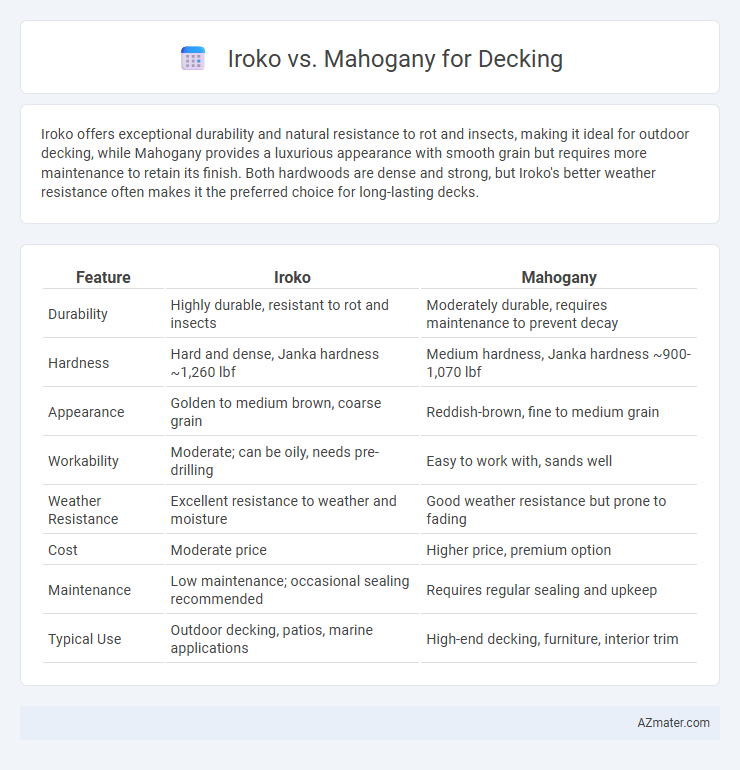Iroko offers exceptional durability and natural resistance to rot and insects, making it ideal for outdoor decking, while Mahogany provides a luxurious appearance with smooth grain but requires more maintenance to retain its finish. Both hardwoods are dense and strong, but Iroko's better weather resistance often makes it the preferred choice for long-lasting decks.
Table of Comparison
| Feature | Iroko | Mahogany |
|---|---|---|
| Durability | Highly durable, resistant to rot and insects | Moderately durable, requires maintenance to prevent decay |
| Hardness | Hard and dense, Janka hardness ~1,260 lbf | Medium hardness, Janka hardness ~900-1,070 lbf |
| Appearance | Golden to medium brown, coarse grain | Reddish-brown, fine to medium grain |
| Workability | Moderate; can be oily, needs pre-drilling | Easy to work with, sands well |
| Weather Resistance | Excellent resistance to weather and moisture | Good weather resistance but prone to fading |
| Cost | Moderate price | Higher price, premium option |
| Maintenance | Low maintenance; occasional sealing recommended | Requires regular sealing and upkeep |
| Typical Use | Outdoor decking, patios, marine applications | High-end decking, furniture, interior trim |
Introduction to Iroko and Mahogany Decking
Iroko decking is renowned for its exceptional durability, natural resistance to rot, and golden to medium brown hues that deepen with aging, making it a popular choice for outdoor structures. Mahogany decking offers a rich reddish-brown color, smooth grain, and remarkable strength, providing both aesthetic appeal and long-lasting performance in exterior applications. Both hardwoods present excellent resistance to moisture and insects, ensuring longevity and minimal maintenance for decking projects.
Key Differences Between Iroko and Mahogany
Iroko decking is prized for its exceptional durability, natural resistance to rot and insects, and yellow to golden-brown hues that deepen with age, making it ideal for outdoor use. Mahogany offers a rich reddish-brown color, fine straight grain, and a smoother finish, but it typically requires more maintenance to maintain its appearance and resist weathering. The key differences lie in Iroko's superior weather resistance and lower maintenance demands compared to Mahogany's aesthetic appeal and softer texture, influencing deck longevity and upkeep requirements.
Durability and Lifespan Comparison
Iroko wood offers exceptional durability with natural resistance to rot, decay, and insect attacks, making it highly suitable for outdoor decking and boasting a lifespan of 25 to 30 years with proper maintenance. Mahogany, known for its dense hardwood properties, also provides strong resistance against moisture and pests but typically lasts around 20 to 25 years under similar conditions. The higher natural oils and tighter grain structure in Iroko contribute to its superior long-term performance and reduced maintenance compared to Mahogany decking.
Appearance and Color Variations
Iroko decking showcases a golden to medium brown hue that ages to a silvery gray, providing a warm, natural aesthetic with subtle grain patterns. Mahogany offers rich reddish-brown tones with deep, pronounced grain variations, creating a luxurious and vibrant deck surface. Both woods enhance outdoor spaces with their distinctive colors, but mahogany's red undertones present a more striking visual contrast compared to Iroko's earthy palette.
Weather and Moisture Resistance
Iroko offers superior weather and moisture resistance with its natural oils and dense grain, making it highly durable against rain, humidity, and temperature fluctuations. Mahogany, while also weather-resistant, is softer and may require more maintenance to prevent moisture damage and warping over time. Iroko's exceptional resistance to fungal attacks and rot makes it a preferred choice for decking in harsh climates.
Maintenance Requirements for Each Wood
Iroko decking demands moderate maintenance, requiring periodic cleaning and occasional oiling to preserve its golden-brown hue and resist fungal attacks. Mahogany is higher maintenance due to its susceptibility to weathering, necessitating regular sealing and oil treatments to maintain its rich reddish-brown color and prevent surface cracking. Both woods benefit from proper ventilation and drainage to extend deck lifespan, but Iroko offers more durability with less frequent upkeep in humid environments.
Cost Comparison: Iroko vs Mahogany
Iroko decking typically costs between $10 and $15 per square foot, making it a more affordable option compared to mahogany, which ranges from $15 to $25 per square foot due to its premium quality and aesthetic appeal. While mahogany offers rich color and durability, the higher price reflects its scarcity and demand in the market. Choosing iroko provides a budget-friendly alternative without compromising significantly on durability or appearance.
Sustainability and Environmental Impact
Iroko wood offers superior sustainability benefits due to its fast growth rate and responsible sourcing practices, resulting in a lower environmental footprint compared to Mahogany, which often faces overharvesting concerns and slower regeneration. Iroko's durability and resistance to pests reduce the need for chemical treatments, minimizing environmental toxins in decking applications. In contrast, Mahogany's extraction can lead to deforestation and habitat loss, making Iroko a more eco-friendly option for sustainable decking solutions.
Suitability for Different Climates
Iroko wood, known for its high resistance to moisture, decay, and insect attacks, performs exceptionally well in humid and tropical climates, maintaining durability without extensive maintenance. Mahogany, while prized for its rich color and fine grain, is better suited to mild, temperate climates due to its moderate resistance to weathering and susceptibility to swelling in excessive moisture. Choosing between Iroko and Mahogany for decking depends on climate conditions, with Iroko favored for wet, variable environments and Mahogany preferred in stable, less humid regions.
Which is Best for Your Decking Project?
Iroko and Mahogany are popular hardwood options for decking, with Iroko offering exceptional durability and natural resistance to rot and insects, making it ideal for high-traffic outdoor spaces. Mahogany, valued for its rich reddish-brown color and smooth texture, provides superior aesthetic appeal and excellent stability, but may require more maintenance to preserve its finish. Choosing between Iroko and Mahogany depends on your priorities for longevity, appearance, and maintenance, with Iroko being best for long-lasting, low-maintenance decks and Mahogany favored for luxurious, warm-toned surfaces.

Infographic: Iroko vs Mahogany for Decking
 azmater.com
azmater.com